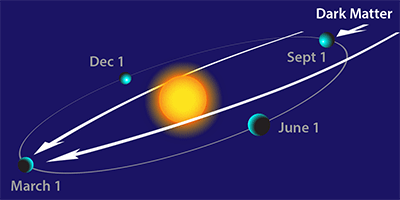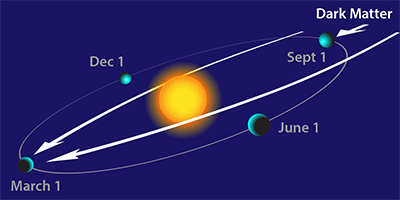Dark-Matter Wind Sways through the Seasons
As the Sun and the entire solar system orbit around the center of the Milky Way, they pass through a halo of dark matter thought to be present in our galaxy. This movement should generate a constant dark-matter “wind” on our planet, a stream of particles that dark-matter searches are hoping to capture. The Earth’s orbit around the Sun also causes an annual modulation of this wind, which could be used to recognize a genuine dark-matter signal in experiments. A new study in Physical Review Letters suggests the modulation could also be profoundly affected by a so-far neglected phenomenon: the distortion of the path of dark-matter particles due to the gravitational focusing of the Sun.
Samuel Lee at the Princeton Center for Theoretical Sciences, New Jersey, and colleagues have analyzed how the Sun’s presence affects the dark-matter wind over the course of a year: In September, the Earth is in front of the Sun, fully exposed to the wind. In spring, it is on the opposite side of the Sun and the dark-matter wind must first cross the star’s gravitational field, which focuses the flux of dark matter like a lens. Lee et al.’s calculations show that this lensing effect should not significantly affect the amplitude of the modulation but could alter its phase, causing the maxima and minima in the wind flow to shift by up to several weeks. The authors show that the effect should be relevant for both the light and heavy dark-matter particles envisioned by various leading theories. – Matteo Rini





